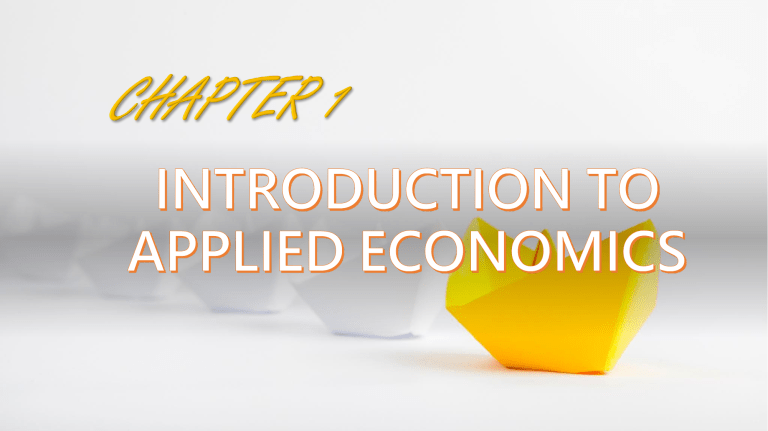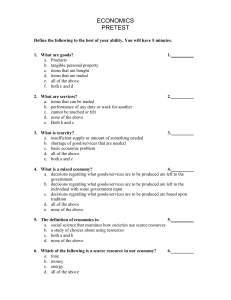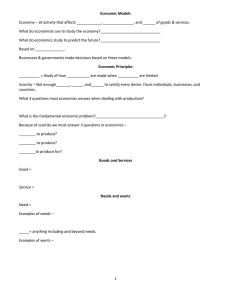Applied Economics Introduction: Scarcity, Trade-offs, and More
advertisement

..\..\..\..\..\..\..\..\ ALONG FILES\DepEd Application\Sarah dep ed application\TIMBR EZA, SARAH [DEMO FOR SHS]\FamilyFeud6. 6.pptm What are the other needs and wants apart from the answers presented, which you believe are also vital in your life? Support your answer. Why should you prioritize your needs over your wants? Do you think it makes your life better? Learning Objectives Define define basic terms in applied economics Identify identify the basic economic problems of the country; Discuss discuss how applied economics can be used to solve economic problems. Develop Develop a sense of responsibility to make meaningful decisions which are useful in addressing the economic problems. Economics • Economics is the study of how people and society end up choosing, with or without use of money, to employ scarce resources that could have alternative uses to produce various commodities among various persons and groups in society. -Samuelson and Nordhaus (2010) WHY DO WE STUDY ECONOMICS? Economics can help students know that everybody, including the government, to budget and appropriately allocate the use of whatever resources are available. Economics will also allow students to understand the efforts on how our government leaders, local and national level, try to shape up the economy of the country for the good of the nation. Scarcity •A condition facing all societies because productive resources are not enough to satisfy people’s unlimited wants and needs. MAKE CHOICES OR DECISIONS Economics is about making choices Economics, today and tomorrow, states that economics concerns situations in which choices must be made about how to use limited resources, when to use them and for what purposes. -(Roger Le Roy Miller, 1978) How will you allocate the scarce resources? Buy a secondhand laptop or save for College? Get a part-time job or focus on your studies? As a student, what will you choose? Productive resources are limited. Therefore, you cannot have all the goods and services you want, as a result you must choose some things and give up others. TRADE-OFFS • A trade-off is an exchange of one thing for another, or accepting less of one thing for more of another. OPPORTUNITY COST • Opportunity cost is the value of something when a particular course of action is chosen. Simply put, the opportunity cost is what you must forgo in order to get something. BASIS FOR COMPARISON TRADE-OFF OPPORTUNITY COST Meaning Trade-off implies the Opportunity cost exchange of one thing implies the value of to get the another. choice foregone, to get something else. What is it? The choices sacrificed. The value of next best alternative. Represents What is given up to get what is wanted? What could have been done, with what was given up? WHAT IS THE OPPORTUNITY COST? • Raul is an OFW working as an engineer in Singapore, he receives P50, 000.oo per month as salary. However, due to Covid-19 pandemic he decided to resign from his work and go back to the Philippines to be with his family and take good care of them. WHAT IS THE OPPORTUNITY COST? Andrew is studying at Tagum City National Trade School, his final exam is fast approaching, he has one (1) week to prepare. Thus, Andrew decided to study his lessons instead of going out with his friends to play mobile games. Differentiate the Needs and Wants A need is something you have to have, something you cannot do without. These are the things that we cannot live without. A want is something you would like to have. It is not absolutely necessary, but it would be a good thing to have. These are the things that we can live without. Applied Economics in Relation to Philippine Economic Problems Unemployment is still a main problem of the Philippine economy with an unemployment rate rose to 17.7 percent accounting to 7.3 million unemployed Filipinos in the labor force in April 2020. According to the PSA, this is a high record in the unemployment rate reflecting the effects of Corona virus disease 2019 (COVID-19) economic shutdown to the Philippine labor market. Poverty According to the Philippine Statistics Authority, in the first semester of 2018, a family of five needed no less than P7,337, on average, to meet the family’s basic food needs for a month. On the other hand, no less than P10,481, on average, was needed to meet both basic food and non-food needs of a family of five in a month. The booming population growth in the Philippines is another basic economic problem that can be connected to the issue of scarcity. When population becomes too big, economic resources may no longer be enough to support the growing population. According to the 2014 census, the Philippine population stood at 100 million. As of 2020, from World Population Review data, it has reached 110 million people. CHILD LABOR AND HIGH ILLITERACY RATE 1. What will happen if there is no scarcity? 2. Does the fact that something is abundant mean it is not scarce in the economic sense? Why or why not? 3. As a student, how can you contribute to the productive capacity of the nation? GROUP 1 - CONCEPT MAP GROUP 2 - VENN DIAGRAM GROUP 3 - CONTEMPLATION RUBRICS 25 POINTS 20 POINTS 15 POINTS 10 POINTS 5POINTS The statement is clearly defined. Appropriate relevant information and details are shared from a variety of sources including personal experiences, observation and prior knowledge. The idea can be identified. Shares some information, facts and experiences, but lacking of relevant observation. The idea can be identified. Shares some information, facts and experiences, but lacking of relevant observation. The main idea can be identified. Share some information The idea is not clearly stated ASSIGNMENT Please do research about the types of economic resources and provide examples using a photo collage. This shall be submitted on the next meeting.




